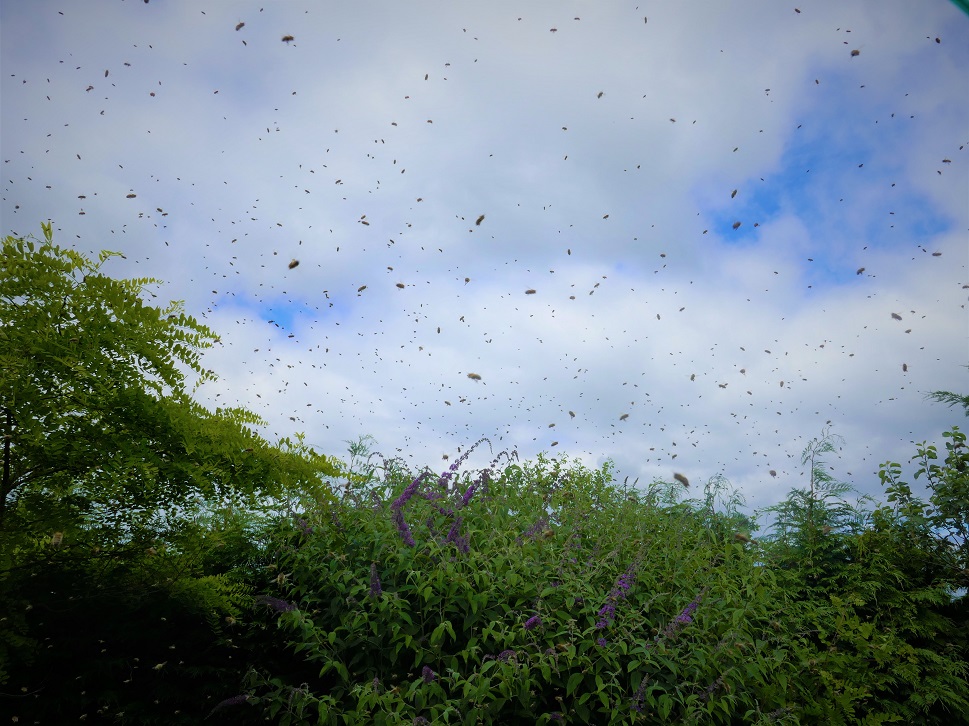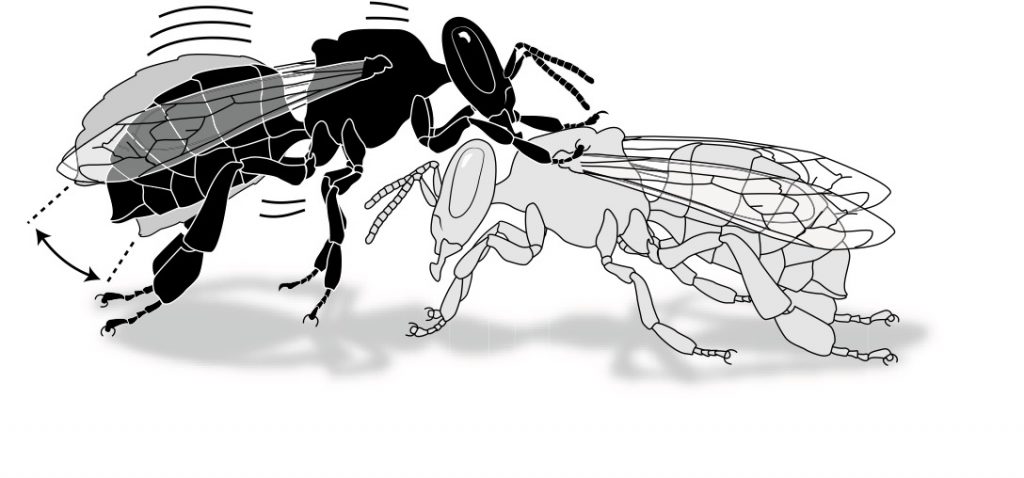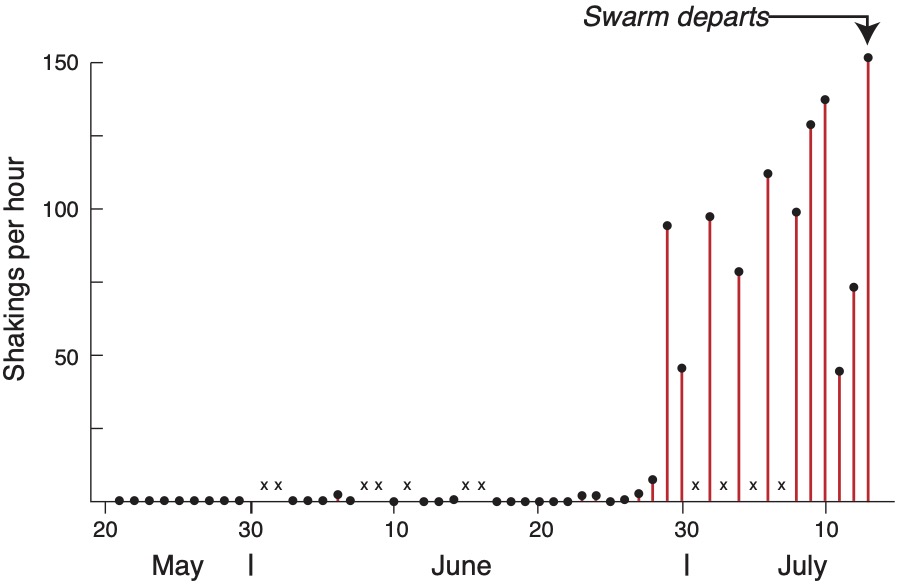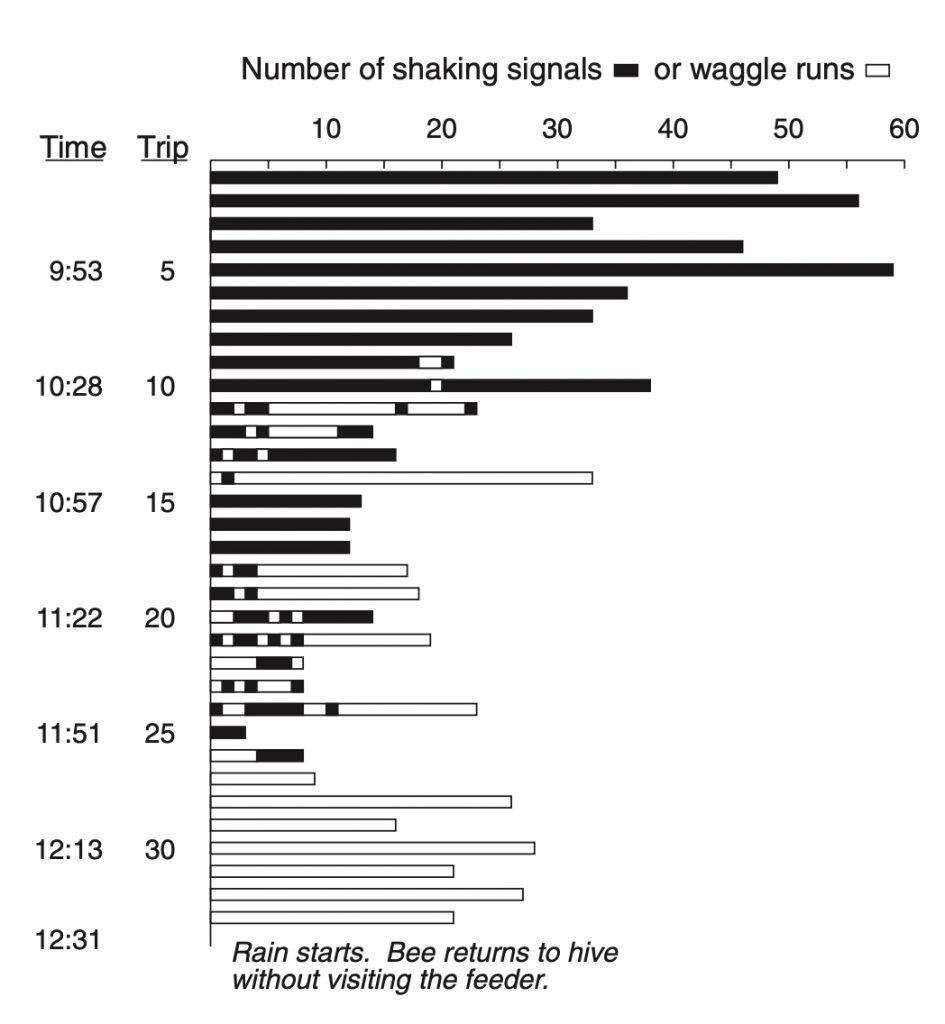
Our season here in the Scottish Highlands is getting off to a slow start on account of cold and variable weather, but there are drones flying in all three apiaries and swarm season awaits. This week we are fortunate to have another fascinating story of discovery from regular Beelistener guest blogger Professor Tom Seeley. Thank you, Tom, for explaining fully the shaking signal and all the collaborative work that went on behind the scenes of discovery. I think that most of us probably just marvel at the revelations of science and new information without wondering too much about how discoveries came about. But if you have ever puzzled over how it is possible for a heavy egg-laden queen to fly with a swarm, the answer is here.
Observations.
I suspect that most beekeepers have observed, from time to time, one worker bee grab hold of another bee with her fore legs and then shake her whole body up and down for 1-2 seconds (Fig. 1). After producing one of these shakings, the shaker will typically crawl a short distance across the comb and shake another bee. This behavior has been given various names, including dorso-ventral abdominal vibration (“D-VAV”), shaking signal, jerking dance, and vibratory dance. I think that calling this behavior a “dance” is misleading because it is a very brief behavior, so it is not suggestive of a dance. I think, too, that the name “dorso-ventral abdominal vibration” is a misnomer because a bee producing this signal vibrates dorsoventrally her entire body, not just her abdomen. I suggest that the most appropriate of its various names is “shaking signal.” My aim here, though, is to discuss the function of this eye-catching behavior.

Fig. 1. A worker bee producing the shaking signal.
Several pieces of evidence suggest that the shaking signal serves to activate the bee that gets shaken. The first solid evidence about the message of this signal came a study that focused on worker bees shaking their queen. This study was conducted by M. Delia Allen, a young woman who worked in the Beekeeping Research Department of the North of Scotland College of Agriculture near Aberdeen. Her studies of the occurrence and significance of the shaking signal earned her a Ph.D. from the University of London in 1958. Allen began her investigations in 1954, with the aim of understanding how the workers in a colony prepare their mother queen for her departure in a swarm. Allen established a small colony headed by a year-old queen in a three-frame observation hive that was connected to the outdoors by a tunnel. She then watched this colony, to see how the workers’ behavior around their queen changed as the colony prepared to swarm.
Allen recorded in detail how the colony’s queen was shaken as the colony prepared to swarm (Fig. 2). Her findings showed that the workers’ shaking of their queen is a means of preparing her for flight. The frequent bouts of shaking caused the queen to walk around more than usual. This increased walking by the queen—together with decreased feeding of her and decreased egg laying by her—caused her to lose weight during this pre-swarm period. A mated queen sheds about 25% of her body weight when her colony prepares to swarm.

Fig. 2. Shaking of the queen by workers in a honey bee colony preparing to swarm. Queen cell building started on 23 June, and a few days later the workers began to shake the queen, evidently to prepare her for flight. X’s mark days when data were not collected.
Starting in the 1980s, other biologists, especially Stan Schneider at the University of North Carolina at Charlotte, studied the shaking signal further, but with a focus on workers shaking other workers. These investigations found that worker bees usually produce this signal either shortly after they have begun foraging, or even before their colony’s foraging has begun. Thus it became clear that when the shaking signal is directed at other workers, it has the same message as when it is directed at a queen: “Prepare for greater activity.”
In the summer of 1994, I saw a clear demonstration of how foragers use this signal to rouse fellow foragers to action. I was working at the Cranberry Lake Biological Station (CLBS), which is in a heavily forested region of northern New York State. With me were two students from Germany, Susanne Kühnholz and Anja Weidenmüller. None of us was thinking about the shaking signal when we began our work. Our goal was to understand the interplay between a colony’s collection of water and nectar when a colony becomes overheated and needs to boost it intake of water for evaporative cooling.

So, we trained a group of 15 bees from a small colony living in an observation hive (Fig. 3) to forage at a sugar-water feeder—it was the only significant source of “nectar” for this colony—and we labeled each of these nectar-forager bees for individual identification. Then we stimulated the colony’s water-collector bees to spring into action. We did so by heating the hive with a lamp. Susanne put paint marks on several water collectors that she found going to wet rocks along the lake’s shore. Meanwhile, Anja made observations of the bees inside the hive. We wanted to see if stimulating a colony’s water collection inhibits it’s nectar collection. We found that it does not. Thus we learned that the water collection and nectar collection sectors of a colony’s economy operate independently.
Fig. 3. The observation hive housed in a portable hut: (1) hive with transparent entrance tunnel, (2) threaded rods for suspended hive, (3) shelf to which the hive was anchored, (4) window, (5) shuttered windows.
It was at the end of a spell of foul weather in June that one of the bees visiting our sugar-water feeder presented us with a surprise clue about what stimulates a nectar collector to produce shaking signals. The days of June 15 and 16 were chilly and rainy at the CLBS, so our water collectors and “nectar” collectors did not leave the observation hive and I did not set up the sugar-water feeder. June 17, however, was warm and sunny, so I filled the feeder shortly after 8 AM, settled into my lawn chair beside it, and waited for bees to resume making trips to the feeder. My job was to record when each “nectar” collector (all were labeled for individual ID) arrived at and departed from the feeder.
Soon, one of our “nectar” collector bees showed up at the feeder. It was the bee bearing a dot of red paint on her thorax, Red Thorax. I called via walkie-talkie to Anja, who was sitting beside the observation hive, to alert her to keep a sharp lookout for Red Thorax and to tell me if she performed a waggle dance when she got back to the hive. I certainly expected her to do so, for the feeder was loaded with a rich sugar syrup and the colony’s rate of nectar intake was rock bottom.
A few minutes later, Anja reported that when Red Thorax came in the observation hive, she had scrambled onto the comb just inside the hive’s entrance as usual, but then began to behave strangely. She had dashed around grabbing other bees one at a time and then (while still grasping a bee) shaking her body up and down for a second or so. I couldn’t see this bee, but I could tell that she was producing shaking signals. The behavior of Red Thorax was extremely conspicuous, because all the other foragers in the colony stood almost motionless, just as they had throughout the previous two days of foul weather. I wondered, was Red Thorax shaking other foragers to rouse them to work?
In July and August, we performed four times the protocol of turning our sugar-water feeder off for several days, then turning it back on, and recording what the first bee to the feeder did when she got back inside the observation hive. Consider what we saw when we tracked the bee Red-30, who was the first bee to find the refilled feeder in one replicate of our experiment. She had visited our feeder regularly whenever it was filled on 17, 18, 19, and 20 July. But when we left it empty on 21 and 22 July (both were fair-weather days), she visited it only sporadically.
On the morning of 23 July 1994, at 09:15, I refilled the feeder with sugar syrup. This ended a 64-h period of forage fasting during which we had closed down the one good “nectar” source available to our study colony. The day started sunny and warm, but most of the bees in our study colony remained quiet, essentially motionless, inside the observation hive, probably because there had been little or no food for them to collect during the previous two days. But at 09:19, the bee Red-30 left the hive. She arrived at the feeder at 09:20, and because she was the first bee there, she became our focal bee. She quickly loaded up, and at 09:22 she flew off. At 09:24, Susanne and Anja watched her scurry through the entrance tunnel and into the observation hive. Immediately upon climbing onto the hive’s lower comb, Red-30 began to produce a string of shaking signals; she shook 33 bees during her first 92 seconds inside the hive. Next, she regurgitated, to two nectar-receivers simultaneously, the load of sugar water she had brought home. Then she quickly shook 16 bees and dashed out of the hive. She was excited! For the next 3 hours, I recorded her comings and goings at the feeder, and Susanne and Anja recorded her actions in the hive, especially the signals (shaking signals and waggle runs) that she produced.

Fig. 4. Production of shaking signals and waggle runs by the bee Red-30 on the morning of 23 July 1994.
Figure 4 shows what Susanne and Anja observed. Red-30 produced only shaking signals after each of her first 8 trips to the feeder; then she produced a mixture of shaking signals and waggle runs after her next 18 trips to the feeder; and finally she produced only waggle runs after each of her last 7 trips to the feeder, which we shut off at 12:30.
At this point, you may be wondering whether the immobile foragers that the bee
Red-30 had shaken so excitedly were deep asleep and were getting wake-up calls. Back in 1994, we did not know for certain whether bees sleep, but now we know that they do, so I am sure that these immobile foragers were indeed deep asleep. But I have used up my space, so I must save bee sleep for the subject of another piece for Beelistener.
References
Allen, M.D. 1956. Allen, M.D. 1956. The behaviour of honey bees preparing to swarm. Animal Behaviour 4: 14-22.
Schneider, S.S. 1986. The vibration dance activity of successful foragers of the honeybee, Apis mellifera (Hymenoptera: Apidae). Journal of the Kansas Entomological Society 59: 699-705. Seeley, T.D, A. Weidenmüller, and S. Kühnholz. 1998. The shaking signal of the honey bee informs workers to prepare for greater activity. Ethology 104: 10-
If you enjoyed reading this, you can subscribe to receive future posts by email. Also, if this article helped you with your work, please consider making a small donation to keep our site running. You can do this through the “Donate with Paypal” button that appears at the side of the screen if you are using a desktop, or by scrolling towards the bottom of the page if you are using a mobile.
Thank you, Ann 🐝

Fascinating post. Thank you!
It was a great post, Archie, and we are lucky to have accesss to all this amazing science and discovery.Thank you for commenting on Professor Seeley’s article.
Thank you, Archie. I am glad you found fascinating this glimpse into the hows and whys of the shaking signal..
Wonderful pot. Thank you Tom and Anne.
Hello Stephen, Thank you for sharing your appreciation of Tom’s great article.
Thank you, Stephen. I love how the shaking signal helps us appreciate the behavioral complexity of worker honey bees,
Fascinating. I’m tempted to build a observation hut in my apiary to be able to repeat this kind of test. And I look forward to read more about the bee sleep.
Hello Paul, Thank you for commenting on Professor Seeley’s wonderful description of the shaking signal. I hope you do get the observation hive built this season. I have decided to keep mine going only for the summer months as my shed is not heated.
And btw – great illustrations!
Thank you, that’s so interesting.
I do enjoy your weekly blogs.
Hello Liz, Thank you for your comment and support.